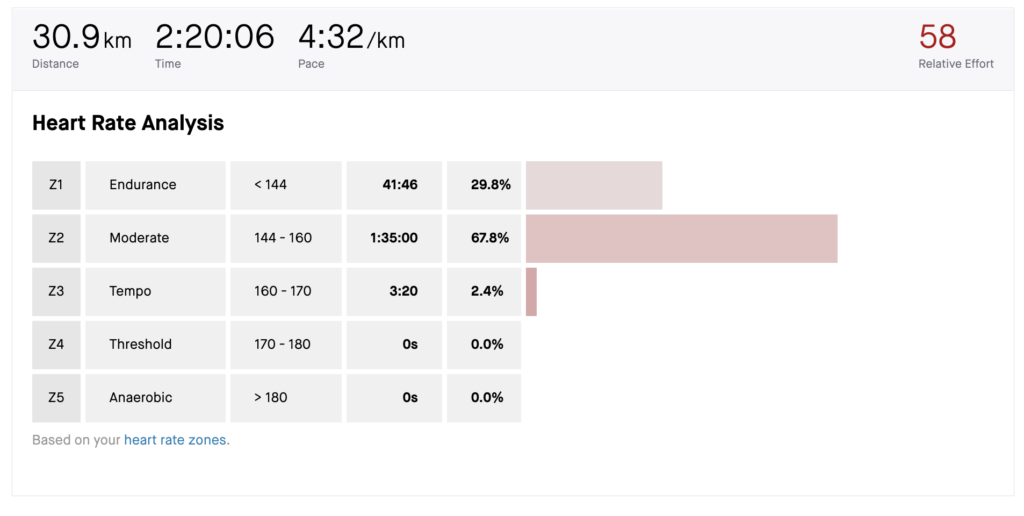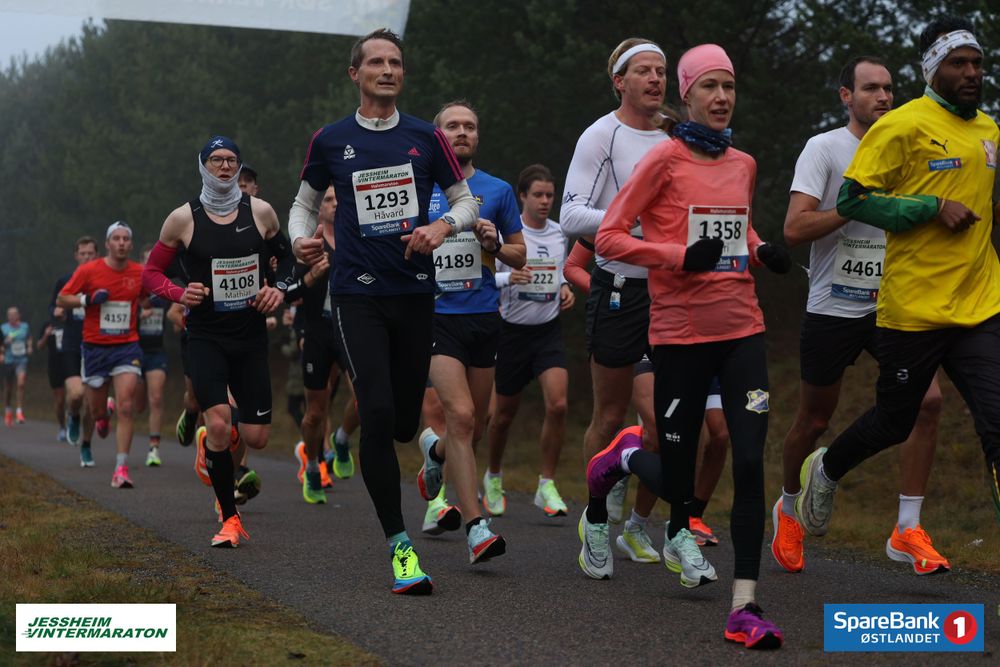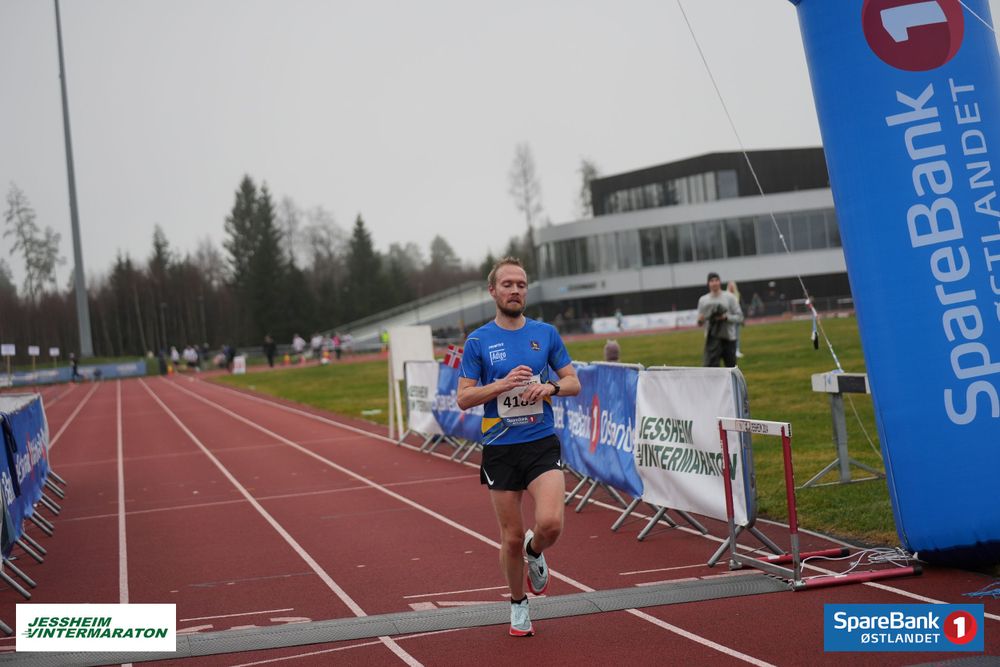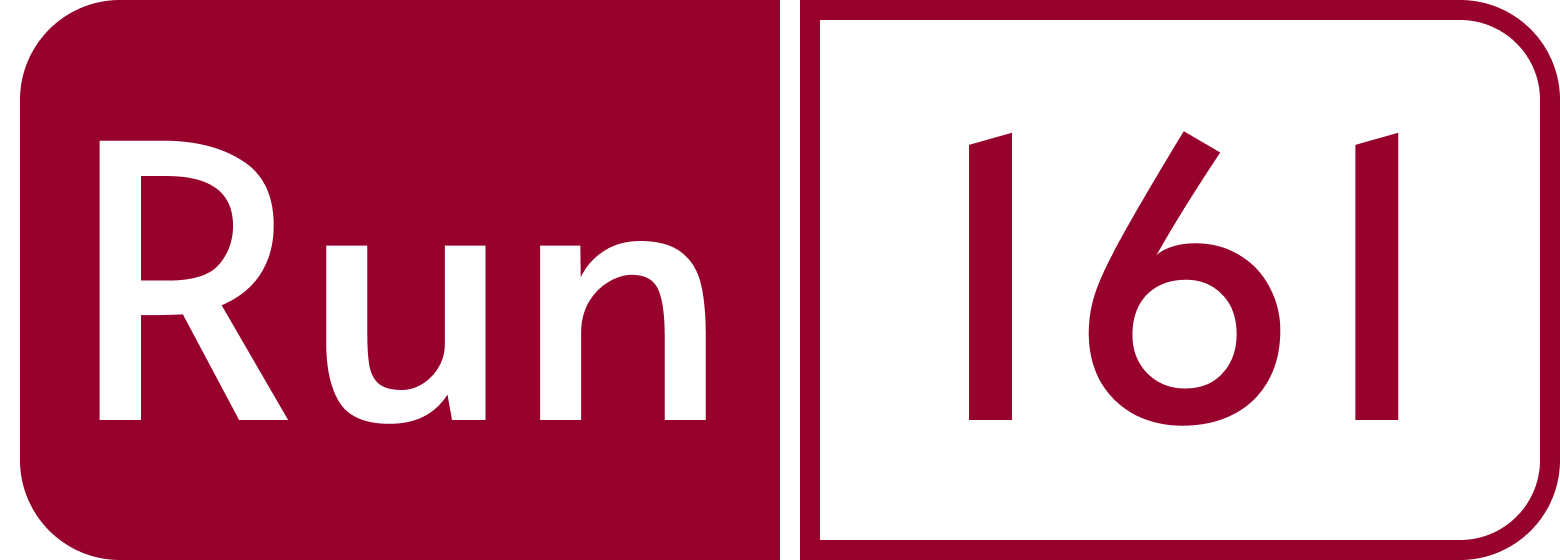Vintermaraton–which, surprisingly, translates to Winter Marathon–is a race rich in history that takes place in the small Oslo suburb of Jessheim every November. Given the time of year, conditions can vary between full winter and running on snow covered roads, to perfect circumstances for running fast.
Like this year.
Due to the unpredictability of the season, I don’t normally race this time of the year. If I’ve run a fall marathon, I’m instead busy building myself back up. Physically, and mentally. After things went south in Berlin seven weeks prior, however, I was motivated to get up for one more race this year.
Training
It’s been a stop and start year of training. As this annotated bar chart of my weekly mileage for the past twelve months shows, consistency has been hard to come by after the covid shutdowns ended.
Despite that, I made a go of getting fit for Berlin–and thoroughly documented the process in detail through the Running to Berlin article series. That covid setback, however, coupled with a nasty stomach bug a few days before the race, lead to a less than enjoyable experience in Berlin
As often happens, impatience for redemption followed failure, and I was back to training again sooner after the marathon than I would advise. The first week after the race I went for a few jogs. The following week, the second post race, I jogged every day. And then, on the third week after the marathon, I was back to full training.
A More Careful Approach
The caveat here is that my training these weeks after running the marathon has been infinitely more responsible. Where before Berlin I was flogging myself twice a week at near race efforts in a last ditch attempt to get marathon-fit, I’m now training with the brakes on.
Structurally, my training remains more or less the simple same:
- A workout on Tuesdays
- A mid-week medium long on Thursdays
- A long run on Sundays
I’m now making a conscious effort to keep the intensity of all three of these sessions under control. For both long runs, that means starting out easy, and then use the upper limit of heart rate zone 2 as a hard cap. For me, that’s just around 80% of HRMax, and it more or less corresponds to the aerobic threshold.
Everything else is just zone 1 recovery jogging, where I aim to stay below 70% of HRMax. After Berlin, I started up with commute runs. That means almost all of my recovery mileage is being done getting to or from work, carrying a backpack with my laptop and a change.
The first two weeks, the added weight was definitely an extra stressor. I had some calf soreness, and the muscles in my upper legs felt flat and tired. But I adjusted quickly, and now these runs feel no more taxing than a regular recovery jog sans backpack.
Easy Does It
Scaling down the training load by reducing the intensity has worked well. While running more or less the same weekly mileage as I did in the months before the marathon, which is around 110 kilometres or 70 miles, doing it now feels easy. Like it’s no big thing.
It’s been a timely reminder. While it’s easy to fall into the trap of measuring the work we do by how many miles we cover, that’s only half the story. Intensity matters.

Coming out of this post-marathon period with lower intensity training, I was unsure about my fitness. The pace to effort and heart rate ratio for my long runs indicated that I was bouncing back well. But, at the same time, Berlin gave me no real answers about where I was at that point.
And surely the almost total lack of anything faster than what I would characterise as marathon pace in workouts meant I would be lacking sharpness in a race situation? A few unknowns going into the race, in other words.
Race
As I mentioned at the top, the race conditions were absolutely perfect. With temperatures around 5° Celsius / 40° Fahrenheit, a light cloud cover and next to no wind, there were no excuses on offer here.
In addition to my training leading up the race, there was also another factor that urged me towards caution on this day. I haven’t had a good race in years.
Admittedly, I don’t race too much. My season usually revolves around a marathon, and I consider everything else training. Still, I’ve blown up in all four races I’ve run the past year. At some point, that gets to you, and your confidence starts to waver.
So my primary goal here was to have a good experience. To stay in control for at least the first half, before hopefully turning it on a bit.
Start to 5 km
The race starts on a track, and opens with a three-quarter lap around before going out on the road. As always, people sprinted with reckless abandon when the gun sounded. For context, at the 200 metre mark, I was probably number 150 of about 700 total runners. And I would go on to finish as number 34.
I tried to find my rhythm from the get go. After exiting the track, I caught up to and settled in behind the 1:20 pacer. Sitting there for the first couple of kilometres made sense, given my goal.

Before long, the group around me grew to at least 20 runners. I was tucked in and staying warm, and shielded from what little wind was blowing just off the front of the pack. A nice place to be. Additionally, my watch indicated that we were going a little faster than 1:20 pace as well, so I decided to get comfortable.
As we hit 5 kilometres, I was still fresh enough to get through some calculations with a certain degree of confidence. I discovered that we were on pace for 1:19 flat. That suited me just fine, as I thought perhaps opening the first half at 1:20 pace might be on the slower side.
5 km to 10.54875 km
On my way to the race, I discovered that I’d forgotten my heart rate strap. I thought about going back. Instead, I decided on taking this as an opportunity to practise going by feel. To avoid being thrown off my faulty data, I disabled the wrist heart rate sensor and went in “naked”.
During the race, this felt like a burden lifted from my shoulders. Approaching 10 kilometres, I felt so ridiculously good. Since I had no data to “calibrate” this feeling against (”is my heart rate too high or too low for how I’m feeling or how fast I’m running?”) I just had to accept that it was a good day.
I was aching to go, but stayed with the group. We were still on course for just under 1:19 at the 10 kilometre mark, and that was still fast enough for me. Because, although my goal was a positive race experience, I still wanted to take this chance to improve on my three and a half year old personal best.
It stood at 1:18:52.
10.54875 km to 15 km
After the halfway mark I went up next to the pacer. I was still biding my time, but at this point I was just waiting for the right moment.
Right as we passed the 12 kilometre marker, another guy came past. That was my cue, and I latched on to him. We passed a few other guys who tried to hang, but couldn’t.
I was still feeling fantastic. My breathing was well controlled, and mechanically I had no trouble running at a clip I’d barely touched for many months. I knew I could run faster still. But, once more, I reminded myself that it’s a waiting game. “Sit behind and don’t make any moves before 15 kilometres,” I told myself.
15 km to 21.097 km
“Let’s see if I can hit 3:30 per kilometre from here on and out,” I thought to myself, and went for it. That’s around 5:38 per mile, by the way. Because why not? It’s a nice, round number after all.
At this point I had no idea what time I was running for. After speeding up, I had passed the point of no return for doing mental maths. Given the halfway split, I knew my personal best was going down, but I didn’t think about that at this point. My only thought was to dig deep, and run fast.
I passed a few people, and then eventually caught up to one guy I recognised as having run the first half in the same group as I did. His pace was honest, and I decided to tuck in behind for a while.
For the final two kilometres, however, I knew I had a little extra in the tank. Switching gears, I passed the guy and let rip. But the guy wouldn’t have it. He decided to hang on, and the sound of his Alphaflys slapping the ground let me know that he was matching me step for step.
I’ll have nightmares about being chased by people in Alphaflys after this, I’m sure.
Coming up to the track and the final quarter lap that marked the end of the race, he came past me. He told me to “come on, keep pushing” so I did. I couldn’t quite hang on to him, but I managed to speed up a little more.

Eventually I passed the finish line. As you can see from the picture above, I ruined another potentially glorious finish line shot by stopping my watch. Don’t do it people! The official time is all that matters.
After Finishing
My official net time was 1:17:15.
It’s a new personal best by a minute and thirty-seven seconds. More importantly on this day, it was a negative split by almost two minutes, and a much welcome return to well executed racing for me.
Of course, it didn’t take long before I started thinking about what I could’ve run. In the back of my mind, I’m quickly thinking that, with the work I’ve put in over the last two years, I should be running faster.
But I try to put that aside. Instead, focus on the positives. The great experience, and that this is validation that you can run fast(er) without flogging yourself in workouts. That once I can get it all to align, all that work will yield even greater payoffs.
So going forward, I’ll continue to practise caution in the coming months. To train within myself. Keep the mileage decent, but at a very measured intensity. Hopefully that will mean improved consistency, and, ultimately, faster times.
Like this?
Let me know by sending me an email at lc@run161.com.
